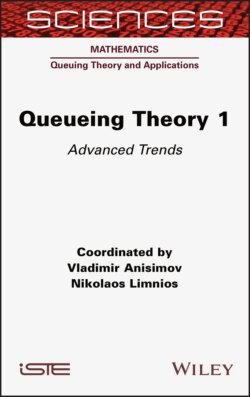Читать книгу Queueing Theory 1 - Nikolaos Limnios - Страница 2
Table of Contents
Оглавление1 Cover
2 Title Page
3 Copyright
4 Preface
5 1 Discrete Time Single-server Queues with Interdependent Interarrival and Service Times 1.1. Introduction 1.2. The Geo/Geo/1 case 1.3. The PH/PH/1 case 1.4. The model with multiple interarrival time distributions 1.5. Interdependent interarrival and service times 1.6. Conclusion 1.7. Acknowledgements 1.8. References
6 2 Busy Period, Congestion Analysis and Loss Probability in Fluid Queues 2.1. Introduction 2.2. Modeling a link under congestion and buffer fluctuations 2.3. Fluid queue with finite buffer 2.4. Conclusion 2.5. References
7 3 Diffusion Approximation of Queueing Systems and Networks 3.1. Introduction 3.2. Markov queueing processes 3.3. Average and diffusion approximation 3.4. Markov queueing systems 3.5. Markov queueing networks 3.6. Semi–Markov queueing systems 3.7. Acknowledgements 3.8. References
8 4 First-come First-served Retrial Queueing System by Laszlo Lakatos and its Modifications 4.1. Introduction 4.2. A contribution by Laszlo Lakatos and his disciples 4.3. A contribution by E.V. Koba 4.4. An Erlangian and hyper-Erlangian approximation for a Laszlo Lakatos-type queueing system 4.5. Two models with a combined queueing discipline 4.6. References
9 5 Parameter Mixing in Infinite-server Queues 5.1. Introduction 5.2. The MΛ/Coxn/∞ queue 5.3. Mixing in Markov-modulated infinite-server queues 5.4. Discussion and future work 5.5. References
10 6 Application of Fast Simulation Methods of Queueing Theory for Solving Some High-dimension Combinatorial Problems 6.1. Introduction 6.2. Upper and lower bounds for the number of some k-dimensional subspaces of a given weight over a finite field 6.3. Evaluation of the number of “good” permutations by fast simulation on the SCIT-4 multiprocessor computer complex 6.4. References
11 7 Diffusion and Gaussian Limits for Multichannel Queueing Networks 7.1. Introduction 7.2. Model description and notation 7.3. Local approach to prove limit theorems 7.4. Limit theorems for networks with controlled input flow 7.5. Gaussian approximation of networks with input flow of general structure 7.6. Limit processes for network with time-dependent input flow 7.7. Conclusion 7.8. Acknowledgements 7.9. References
12 8 Recent Results in Finite-source Retrial Queues with Collisions 8.1. Introduction 8.2. Model description and notations 8.3. Systems with a reliable server 8.4. Systems with an unreliable server 8.5. Conclusion 8.6. Acknowledgments 8.7. References
13 9 Strong Stability of Queueing Systems and Networks: a Survey and Perspectives 9.1. Introduction 9.2. Preliminary and notations 9.3. Strong stability of queueing systems 9.4. Conclusion and further directions 9.5. References
14 10 Time-varying Queues: a Two-time-scale Approach 10.1. Introduction 10.2. Time-varying queues 10.3. Main results 10.4. Concluding remarks 10.5. References
15 List of Authors
16 Index
17 End User License Agreement
